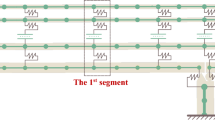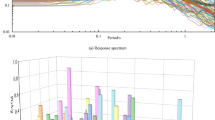Abstract
Based on the construction bridge of Xiamen-Shenzhen high-speed railway (9–32 m simply-supported beam + 6×32 m continuous beam), the pier-beam-track finite element model, where the continuous beam of the ballast track and simply-supported beam are combined with each other, was established. The laws of the track stress, the pier longitudinal stress and the beam-track relative displacement were analyzed. The results show that reducing the longitudinal resistance can effectively reduce the track stress and the pier stress of the continuous beam, and increase the beam-track relative displacement. Increasing the rigid pier stiffness of continuous beam can reduce the track braking stress, increase the pier longitudinal stress and reduce the beam-track relative displacement. Increasing the rigid pier stiffness of simply-supported beam can reduce the track braking stress, the rigid pier longitudinal stress and the beam-track relative displacement.
Similar content being viewed by others
References
ZHANG Ye-zhi, ZHANG Min. Structure and behavior of floor system of two super high-speed railway Changjiang composite bridges [J]. Journal of Central South University of Technology, 2011, 18(2): 542–549.
Bridge Research Institute of Railway Bridge Authority. German Standard DS899/59. Special procedures on railway Shinkansen bridge [S]. 1991.
YIN Cun-xin, PAN Jia-ying, ZHUANG Jun-sheng. On nonlinear static and dynamic analysis and emulation of additional forces in railway bridges [J]. China Railway Science, 2001, 22(5): 133–137. (in Chinese).
XU Qing-yuan. Static and dynamic 3D finite element analysis of longitudinal forces transmission between CWR and high-speed railway bridges [D]. Changsha: Central South University, 2005. (in Chinese).
LI Bao-you. Study on longitudinal force of CWR on bridge for speed-raising trunk line steel truss girder [D]. Changsha: Central South University, 2006. (in Chinese).
JIANG Peng. Interaction between girder and rail of rail transit viaduct with U-shape girder [D]. Shanghai: Tongji University, 2008. (in Chinese).
China Academy of Railway Sciences. [2003]205. Railway construction, interim provisions of CWR design on newly built railway bridge [M]. Beijing: China Railway Press, 2003. (in Chinese).
BATTINI J, MAHIR U. A simple finite element to consider the non-linear influence of the ballast on vibrations of railway bridges [J]. Engineering Structures, 2011, 33(9): 2597–2602.
READ D, LOPRESTI J. Management of rail neutral temperature and longitudinal rail forces [J]. Railway Track and Structures, 2005, 101(8): 18–19.
ORE. Braking and acceleration force on bridges-Measurement and evaluation methods [R]. 1970.
BU Yi-zhi. Research on the transmission mechanism of longitudinal force for high-speed railway bridges [D]. Chengdu: Southwest Jiaotong University, 1998. (in Chinese)
BIONDIA B, MUSCOLINOB G, SOFIB A. A substructure approach for the dynamic analysis of train-track-bridge system [J]. Computers & Structures, 2005, 83(11): 2271–2281.
TB10002.1-2005. Fundamental code for design on railway bridge and culvert [S]. Beijing: China Railway Press, 2005. (in Chinese)
LI Ling-ying. Discussion of live load design standards on high-speed railway small and medium span bridge [D]. Changsha: Central South University, 2011. (in Chinese)
Code for railway CWR design (draft) [S]. Beijing: Institute of Economic Planning Ministry of Railways, 2008. (in Chinese)
YAN Bin, DAI Gong-lian. CWR longitudinal force of cable-stayed bridge on high-speed railway [J]. Journal of the China Railway Society, 2012, 34(3): 83–87. (in Chinese)
Author information
Authors and Affiliations
Corresponding author
Additional information
Foundation item: Project(50678176) supported by the National Natural Science Foundation of China
Rights and permissions
About this article
Cite this article
Yan, B., Dai, Gl. & Zhang, Hp. Beam-track interaction of high-speed railway bridge with ballast track. J. Cent. South Univ. Technol. 19, 1447–1453 (2012). https://doi.org/10.1007/s11771-012-1161-8
Received:
Accepted:
Published:
Issue Date:
DOI: https://doi.org/10.1007/s11771-012-1161-8




